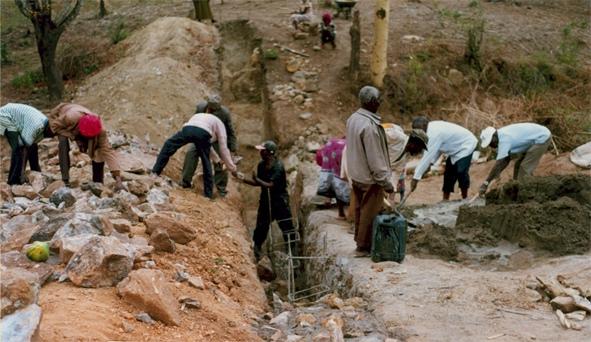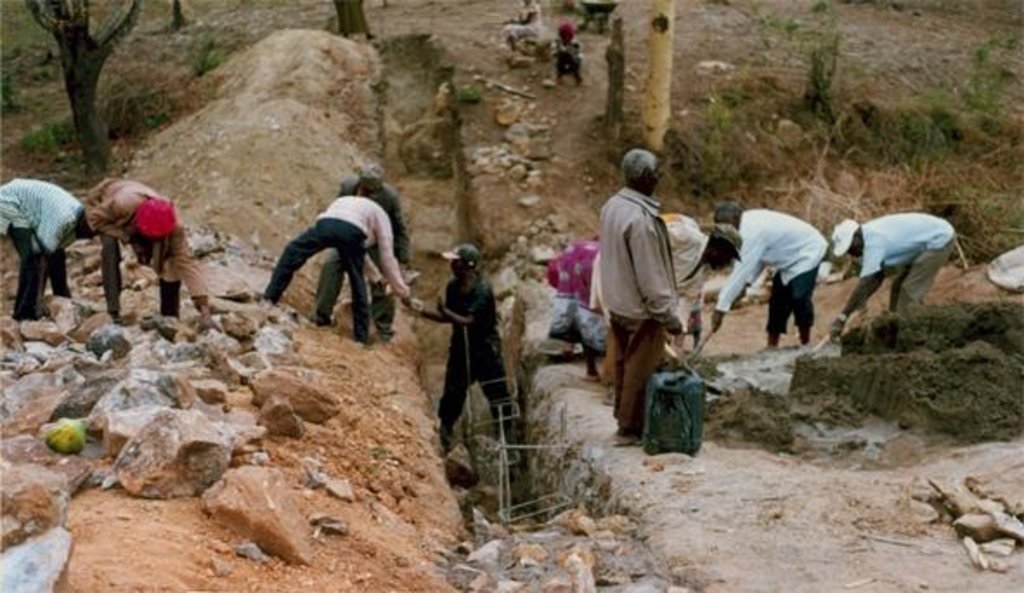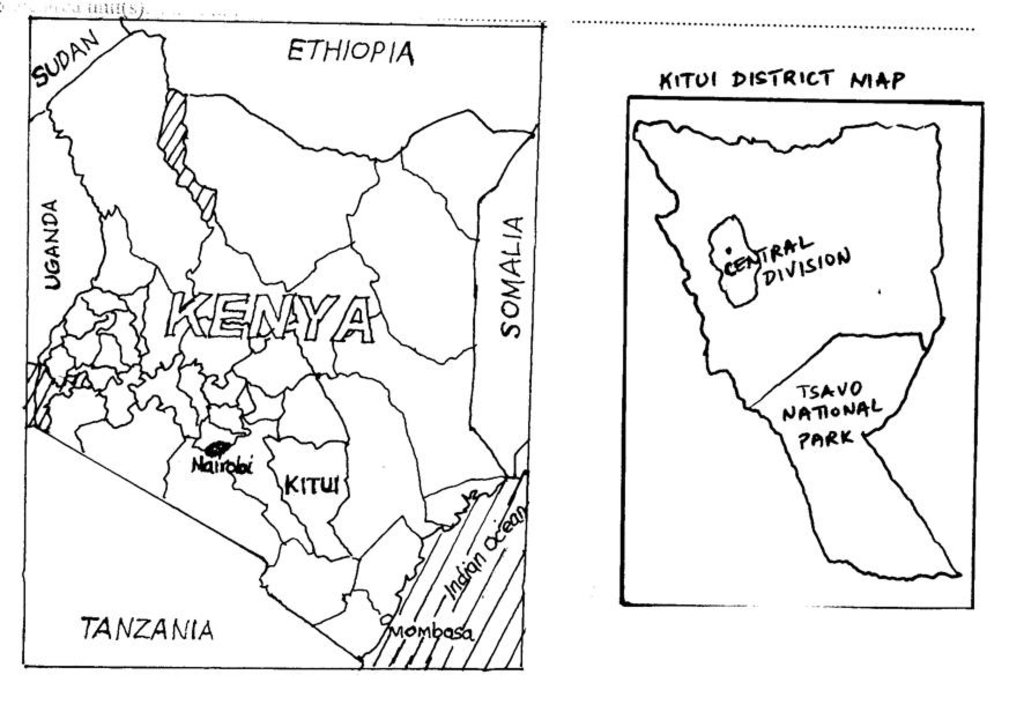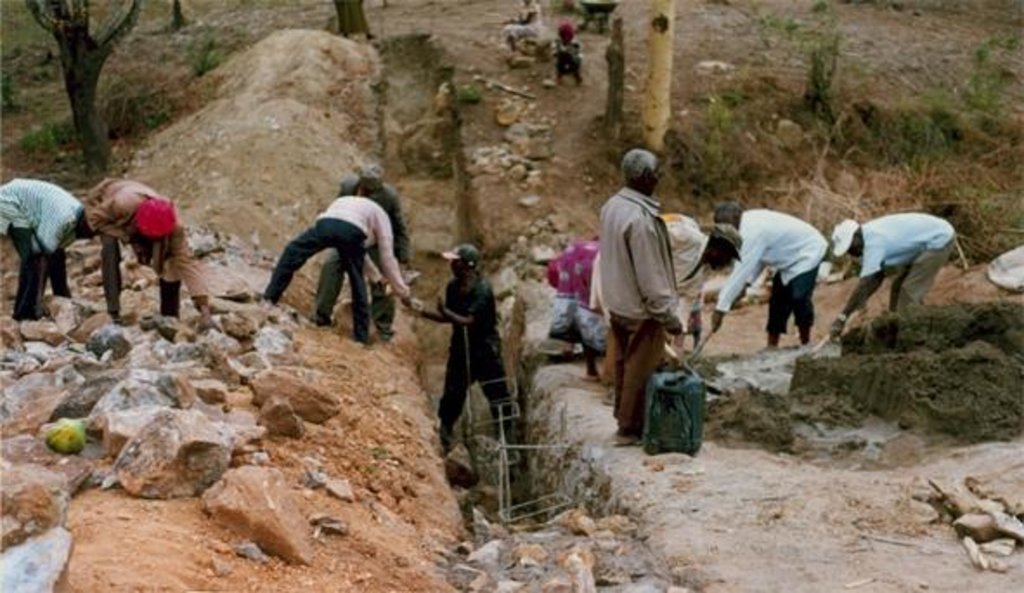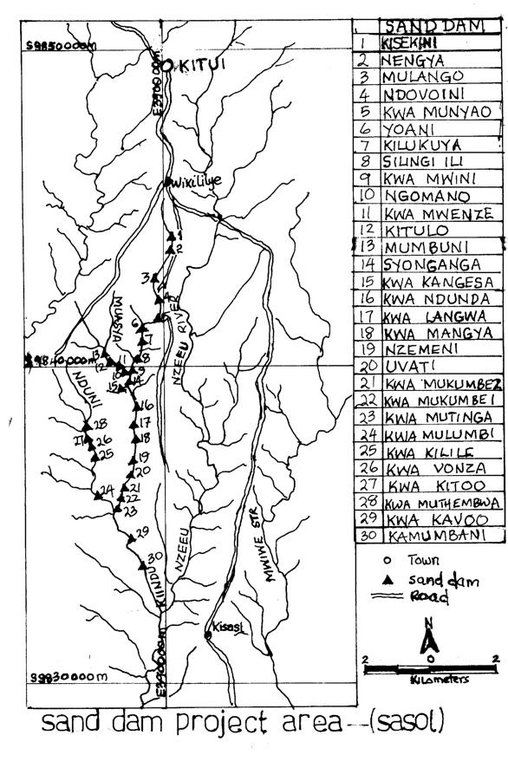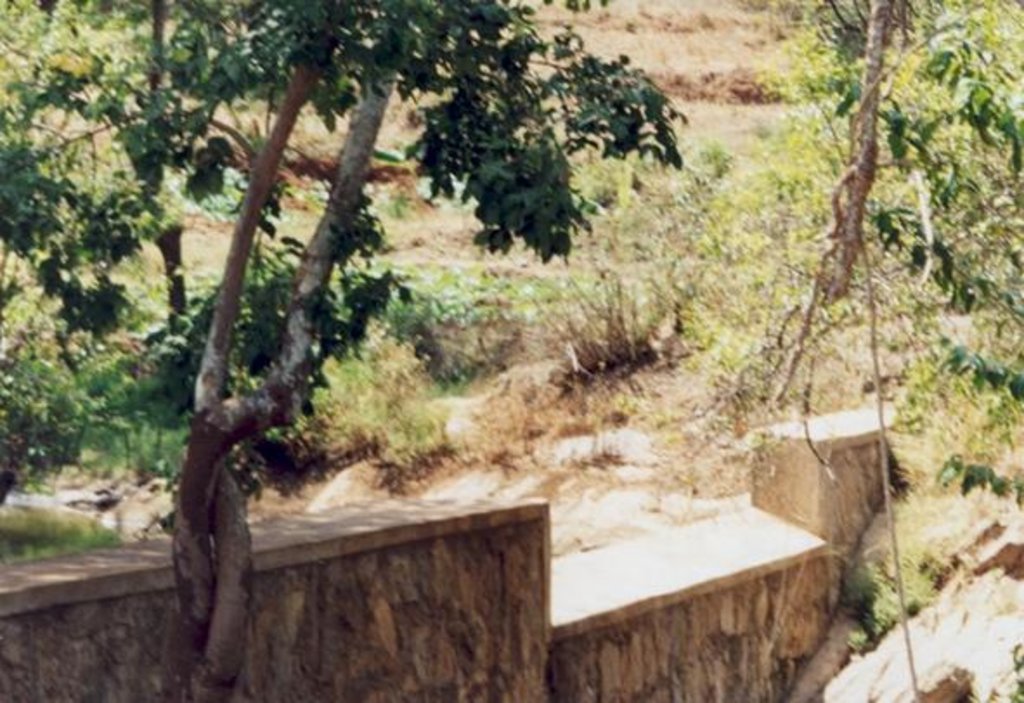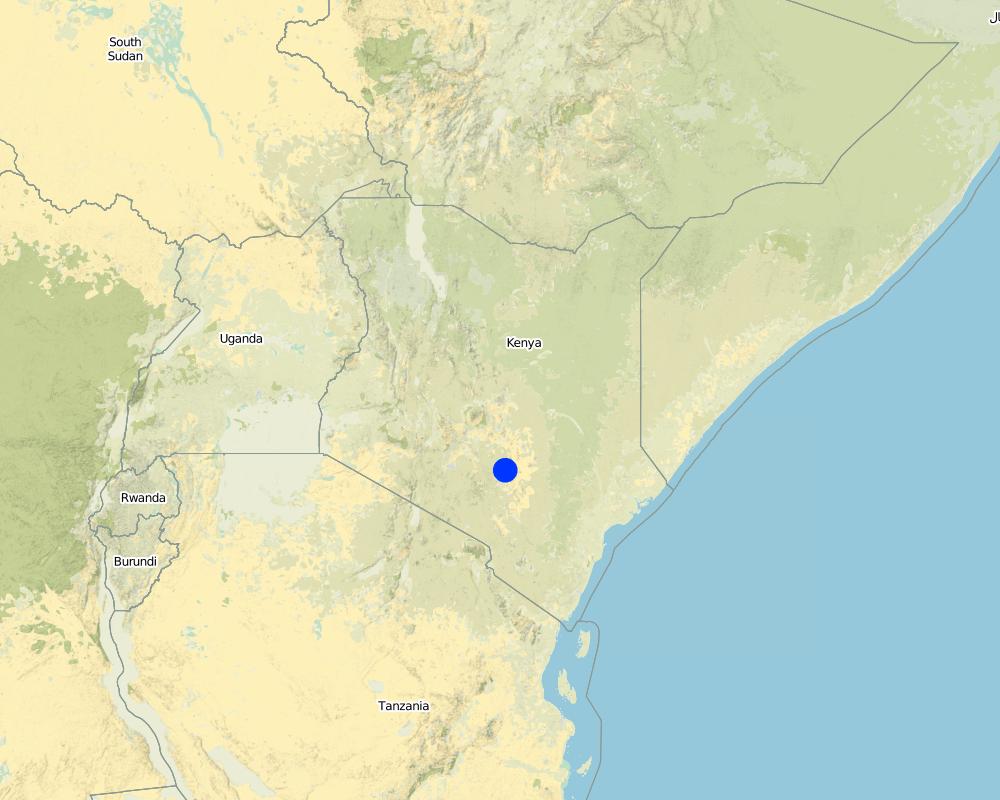SASOL community approach - for sand dams in Kitui [Kenya]
- Création :
- Mise à jour :
- Compilateur : Donald B. Thomas
- Rédacteur : –
- Examinateur : Fabian Ottiger
approaches_2358 - Kenya
Voir les sections
Développer tout Réduire tout1. Informations générales
1.2 Coordonnées des personnes-ressources et des institutions impliquées dans l'évaluation et la documentation de l'Approche
Spécialiste GDT:
Mutiso Sam
sasol@kenyaweb.com
SASOL Foundation
PO Box 85 Kitui Kenya
Kenya
Nom du ou des institutions qui ont facilité la documentation/ l'évaluation de l'Approche (si pertinent)
Sahelian Solutions Foundation (SASOL) - Kenya1.3 Conditions relatives à l'utilisation par WOCAT des données documentées
Le compilateur et la(les) personne(s) ressource(s) acceptent les conditions relatives à l'utilisation par WOCAT des données documentées:
Oui
1.4 Références au(x) questionnaire(s) sur les Technologies de GDT
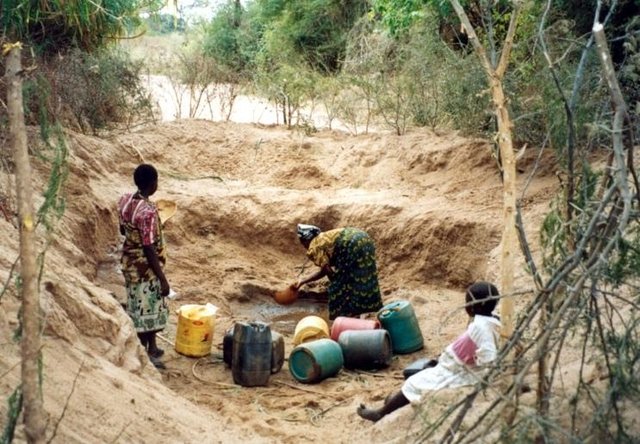
Kitui Sand dams [Kenya]
Masonry dam in seasonal watercourse or river that stores water in the sand which accumulates above it.
- Compilateur : Unknown User
2. Description de l'Approche de GDT
2.1 Courte description de l'Approche
Community based water resource development
2.2 Description détaillée de l'Approche
Description détaillée de l'Approche:
Aims / objectives: Purpose is to harness the available water resource for common interests. Objective is to make water more accesible especially in the dry season.
Methods: Communities are mobilised through participation process. Local artisans are trained on the job wherease the community provide local materials and free labour voluntarily. Supporting NGOs facilitate the training and provide inputs eg cement, reinforcing bars, skilled labour. Community mobilisation is basic to SASOL's programme for water resource development. SASOL take advantage of existing structures and conforms to the government policy refferred to as District focus for Rural Development. Before communities can be mobilised, people, must be trained and SASOL has found that training can best be done at the local level. The role of the community is as follows: 1. To provide secondary data/information 2. Identify problems, resources and propose possible interventions or community action plan. 3. Election of a committee to take charge - custodial of all purchased materials. 4. Collection of local materials and provide labour. 5. Carry out impact assessment periodically
2.3 Photos de l'approche
2.5 Pays/ région/ lieux où l'Approche a été appliquée
Pays:
Kenya
Région/ Etat/ Province:
Eastern
Map
×2.6 Dates de début et de fin de l'Approche
Indiquez l'année de démarrage:
1995
2.7 Type d'Approche
- fondé sur un projet/ programme
2.8 Principaux objectifs de l'Approche
The Approach focused mainly on SLM with other activities (tree nursery establishment, health and hygiene concerns of the community. (Community Trainings))
to build sand dams in all streams in a 200km2 part of Central Division of Kitui District.
The SLM Approach addressed the following problems: Lack of water especially in dry seasonPoor water hygiene and general public health.
2.9 Conditions favorisant ou entravant la mise en œuvre de la(des) Technologie(s) appliquée(s) sous l'Approche
disponibilité/ accès aux ressources et services financiers
- entrave
Lack of funds for cement
Treatment through the SLM Approach: SASOL raises the funds
cadre institutionnel
- entrave
Lack of community organization to address the prevailing problems
Treatment through the SLM Approach: participatory process to identify problems & solutions
connaissances sur la GDT, accès aux supports techniques
- entrave
Lack of trained artisans
Treatment through the SLM Approach: training of artisans
autre
- entrave
roads and access to river valleys
Treatment through the SLM Approach: improvement of roads
3. Participation et rôles des parties prenantes impliquées dans l'Approche
3.1 Parties prenantes impliquées dans l'Approche et rôles
- exploitants locaux des terres / communautés locales
Community village group (water users' group). Working land users were mainly women (most of the men are working outside the district.) Existing groups of land users; Working land users were mainly women (most of the men are working outside the district.)
More men working outside the district.
More women engaged in the daily activities as they are availanle. Sub-locational development committees and self help groups are mobilised for a community training that follows the approach of a PRA. The community selects from 25 to 50 trainnees, both men and women.
- gouvernement national (planificateurs, décideurs)
- organisation internationale
Kenyan political scientist in collaboration with a Netherland hydrogeologist and an environmental planner
3.2 Participation des exploitants locaux des terres/ communautés locales aux différentes phases de l'Approche
| Participation des exploitants locaux des terres/ communautés locales | Spécifiez qui était impliqué et décrivez les activités | |
|---|---|---|
| initiation/ motivation | interactive | Mainly:rapid/participatory rural appraisal; partly: workshops/seminars; PRA was carried out with the assistance of world neighbours |
| planification | interactive | Mainly: rapid/participatory rural appraisal; partly: public meetings; participatory planning exercise |
| mise en œuvre | interactive | responsibility for major steps; collection of local materials labour water etc |
| suivi/ évaluation | interactive | measurements/observations; community observation and comments |
| Research | aucun | water hygiene analysis |
3.4 Prises de décision pour la sélection de la Technologie/ des Technologies
Indiquez qui a décidé de la sélection de la Technologie/ des Technologies à mettre en œuvre:
- principalement les exploitants des terres soutenus par des spécialistes de la GDT
Expliquez:
Consultative through participatory approaches.
Decisions on the method of implementing the SLM Technology were made by mainly by SLM specialists with consultation of land users. consultative
4. Soutien technique, renforcement des capacités et gestion des connaissances
4.1 Renforcement des capacités/ formation
Une formation a-t-elle été dispensée aux exploitants des terres/ autres parties prenantes?
Oui
Spécifiez qui a été formé:
- exploitants des terres
- teachers, school children/students
Formats de la formation:
- sur le tas
- réunions publiques
- cours
Thèmes abordés:
through PRA and on the job
4.2 Service de conseils
Les exploitants des terres ont-ils accès à un service de conseils?
Oui
Décrivez/ commentez:
Name of method used for advisory service: Workshop trainning; Key elements: non residential workshops, Educational tours and visits; 1) Advisory service was carried out through: projects own extension structure and agents 2) Advisory service was carried out through: projects own extension structure and agents; Extension staff: specifically hired project employees 3) Target groups for extension: land users; Activities: SWC, Tree planting, water management
Advisory service is quite adequate to ensure the continuation of land conservation activities; community resource persons trained to make it sustainable.
4.3 Renforcement des institutions (développement organisationnel)
Des institutions ont elles été mises en place ou renforcées par le biais de l'Approche?
- oui, modérément
Spécifiez à quel(s) niveau(x), ces institutions ont été renforcées ou mises en place:
- local
- cooperative activity to solve water problem
4.4 Suivi et évaluation
Le suivi et l'évaluation font ils partie de l'Approche? :
Oui
Commentaires:
bio-physical aspects were ad hoc monitored
technical aspects were regular monitored
economic / production aspects were ad hoc monitored by 0 through observations; indicators: None
no. of land users involved aspects were regular monitored by 0 through measurements; indicators: None
management of Approach aspects were ad hoc monitored by 0 through observations; indicators: None
There were few changes in the Approach as a result of monitoring and evaluation: construction of dam in one single phase as opposed to several phase due to difficulties In comminity mobilisation for subsequent phases. Commencement of construction from wing walls instead of the main structure. This is psycologically attractive to land users as they remain motivated to realise completion of the dam across the river/stream bed.
5. Financement et soutien matériel externe
5.1 Budget annuel de la composante GDT de l'Approche
Si le budget annuel précis n'est pas connu, indiquez une fourchette:
- 100 000-1 000 000
Commentez (par ex. principales sources de financement/ principaux bailleurs de fonds):
Approach costs were met by the following donors: international (-): 50.0%; international non-government (-): 10.0%; local community / land user(s) (-): 40.0%
5.2 Soutiens financiers/ matériels fournis aux exploitants des terres
Les exploitants des terres ont-ils reçu un soutien financier/ matériel pour la mise en œuvre de la Technologie/ des Technologies?
Oui
Si oui, spécifiez le(s) type(s) de soutien, les conditions et les fournisseurs:
Provision of purchased inputs like cement.
5.3 Subventions pour des intrants spécifiques (incluant la main d'œuvre)
- équipement
| Spécifiez les intrants subventionnés | Dans quelle mesure | Spécifiez les subventions |
|---|---|---|
| outils | entièrement financé | |
- matériaux de construction
| Spécifiez les intrants subventionnés | Dans quelle mesure | Spécifiez les subventions |
|---|---|---|
| Cement and reinforced bars | entièrement financé | |
Si la main d'œuvre fournie par les exploitants des terres était un intrant substantiel, elle était:
- volontaire
Commentaires:
Provision of purchased inputs like cement.
5.4 Crédits
Des crédits ont-ils été alloués à travers l'Approche pour les activités de GDT?
Non
6. Analyses d'impact et conclusions
6.1 Impacts de l'Approche
Est-ce que l'Approche a aidé les exploitants des terres à mettre en œuvre et entretenir les Technologies de GDT?
- Non
- Oui, un peu
- Oui, modérément
- Oui, beaucoup
more tree nurseries, more vegetable growing, more time for terracing etc instead of treking for water
N/A
Did other land users / projects adopt the Approach?
- Non
- Oui, un peu
- Oui, modérément
- Oui, beaucoup
other groups using water as an entry point for development e.g. catholic diocese
6.3 Durabilité des activités de l'Approche
Les exploitants des terres peuvent-ils poursuivre ce qui a été mis en œuvre par le biais de l'Approche (sans soutien extérieur)?
- incertain
Si non ou incertain, spécifiez et commentez:
Still need help for purchase of inputs especially cement and reinforced bars
6.4 Points forts/ avantages de l'Approche
| Points forts/ avantages/ possibilités du point de vue de l'exploitant des terres |
|---|
| avail labour readily for demanding activities (How to sustain/ enhance this strength: engage groups in self help farm activities) |
| laggards are pulled along by innovators |
| communal identification of available resources and strngths |
| Points forts/ avantages/ possibilités du point de vue du compilateur ou d'une autre personne ressource clé |
|---|
| Participatory PRA creates awareness (How to sustain/ enhance this strength: through trainings) |
| empowers community (How to sustain/ enhance this strength: start income generating activities) |
| costs minimized through voluntary labour |
| self reliance strengthened |
| community empowered |
6.5 Faiblesses/ inconvénients de l'Approche et moyens de les surmonter
| Faiblesses/ inconvénients/ risques du point de vue de l’exploitant des terres | Comment peuvent-ils être surmontés? |
|---|---|
| materials are too expensive for them to afford | local fund raising initiatives |
| Faiblesses/ inconvénients/ risques du point de vue du compilateur ou d'une autre personne ressource clé | Comment peuvent-ils être surmontés? |
|---|---|
| impact on river flow needs to be studied |
7. Références et liens
7.1 Méthodes/ sources d'information
- visites de terrain, enquêtes sur le terrain
- interviews/entretiens avec les exploitants des terres
7.2 Références des publications disponibles
Titre, auteur, année, ISBN:
Thomas, D.B. 1999'where there is no water.' A story of community water development & dand dams in Kitui District, Kenya
Liens et modules
Développer tout Réduire toutLiens

Kitui Sand dams [Kenya]
Masonry dam in seasonal watercourse or river that stores water in the sand which accumulates above it.
- Compilateur : Unknown User
Modules
Aucun module trouvé


